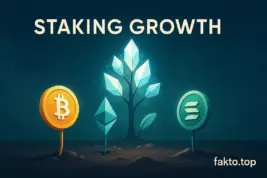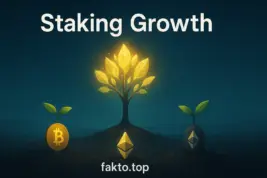Crypto Passive Income: Staking, Yield Farming, RWA & DePIN Strategies
Still Waiting for a Pump? How 95% of Crypto Whales Build Passive Income While You Trade
Yield Generation Explained: Shifting Focus from Speculation to Sustainable Flow
If you’ve been around crypto for more than a season, you probably know the cycle: buy, hold, wait for a pump, maybe sell too early—or worse, too late. Sound familiar? Here’s the thing: whales aren’t sitting around staring at charts like addicts waiting for the next green candle. They’re quietly building streams of passive income, stacking yield day after day while retail traders burn out chasing “the next 100x.”

In this article, we’ll break down exactly how that works. We’ll go through three levels of crypto income generation, starting from the most basic and safe approaches, and moving up to the cutting edge of decentralized finance. Along the way, we’ll cover the risks (no sugarcoating here) and the strategies whales use to keep their flow consistent—even in a bear market.
But first, let’s set the stage: this isn’t financial advice. It’s insight, strategy, and perspective from inside the crypto trenches. Use it to expand your view, not to copy-paste someone else’s moves.
Level 1: Foundational Yield (Staking and Lending)
This is where most people dip their toes into passive crypto income. It’s about putting your coins to work instead of letting them rot in a wallet while you wait for price action. The simplest entry point? staking and lending.
Exchange Staking vs. Decentralized Wallet Staking: Which is Right for You?
Proof-of-Stake (PoS) has fundamentally changed the game. Instead of burning electricity like Bitcoin miners, PoS blockchains reward you for locking your coins into the network. Exchanges like Binance or Coinbase make staking a one-click process—but convenience comes with strings attached. Centralization, custody risk, and even slashing penalties (yes, your coins can get slashed if the validator screws up) are the fine print most users ignore.
On the flip side, staking through a self-custody wallet or validator delegation gives you control. It’s less convenient, sure, but you’re not handing your assets to a corporation that might freeze withdrawals in the next “unexpected maintenance event.” The trade-off: more responsibility, more security consciousness required.
Understanding Liquidity Staking and Minimizing Lock-Up Periods
What if you don’t want your coins frozen for months or years? Enter Liquid Staking Tokens (LSTs) like stETH. They let you stake your ETH but still trade or use the staked asset as collateral in DeFi. It’s like earning yield without losing flexibility—one of those innovations that whales grabbed onto early, while most retail investors kept their ETH idle.

Of course, risks exist. Smart contract vulnerabilities, de-pegging events (remember when stETH briefly traded below ETH?), and the underlying validator risk all apply. But for many, the yield plus liquidity is worth the calculated risk.
| Strategy | Pros | Cons |
|---|---|---|
| Exchange Staking | Easy setup, no technical skills required | Centralized custody, withdrawal risks, slashing exposure |
| Wallet/Validator Staking | Full control, decentralized participation | More technical, responsibility for security |
| Liquid Staking Tokens | Earn yield while keeping liquidity, composable in DeFi | Smart contract risk, potential de-pegging |
But here’s the cold truth: staking isn’t going to make you rich overnight. It’s stable, yes. It’s predictable, yes. But it’s not sexy. This is the foundation—your “savings account” in the crypto world. The real fireworks (and the real risks) start when you move into DeFi yield farming and liquidity provision.
Level 2: Advanced DeFi Income (Yield Farming and Liquidity Provision)
This is where things get interesting—and where many intermediate users hesitate. The promise of fat APYs is intoxicating, but so is the fear of “Impermanent Loss” (IL), a phrase that’s scared away more crypto hopefuls than any bear market ever could.
The Engine of DeFi: How Liquidity Pools and AMMs Generate Fees
At the core of DeFi are Automated Market Makers (AMMs) like Uniswap. Instead of relying on centralized order books, these protocols let traders swap tokens instantly using liquidity pools. The kicker? Every trade generates fees that flow back to liquidity providers (LPs). In other words, while retail traders chase memecoins, LPs quietly rake in a slice of every transaction.
But here’s the insider’s secret: not all pools are equal. Some pools are high-volume, stable, and relatively low-risk (think USDC/USDT). Others are wild jungles of volatility, where you can make bank—or lose it just as fast. And then there’s the elephant in the room: Impermanent Loss.
The Impermanent Loss Risk: What It Is and How to Manage It
Impermanent Loss (IL) is the boogeyman of DeFi—and for good reason. Imagine you provide liquidity in a 50/50 ETH/USDC pool. If ETH’s price doubles, you don’t get the full upside. The pool automatically rebalances, and when you withdraw, you end up with less ETH than you started with. The loss isn’t always permanent—if prices return to where they started, you’re fine—but how often does crypto stay in one place? Exactly.

So how do the pros handle it? They manage IL, they don’t fear it. Whales play the game with strategies like:
- Stablecoin pairs (e.g., USDC/DAI) where volatility is minimal. Boring, but reliable.
- Concentrated liquidity on protocols like Uniswap v3, where you provide liquidity in specific price ranges, maximizing fees while reducing exposure.
- Pairing volatile assets with stablecoins to capture fees while limiting the downside of wild swings.
And here’s the kicker: even with IL, many whales still profit because the trading fees and yield incentives outweigh the potential losses. But don’t kid yourself—if you jump into some obscure memecoin pool chasing a 1,000% APR, you’re gambling, not investing.
Risks? Plenty. Smart contract exploits (DeFi hacks have drained billions), protocol failure, or sudden liquidity exits can wipe out your position. If you skipped our Essential Guide to Crypto Scam Avoidance, this is your reminder: in DeFi, you either understand the risks or you get rekt.
| DeFi Yield Strategy | Potential Yield | Main Risks |
|---|---|---|
| Stablecoin Liquidity Pools | 5–15% annually | Smart contract risk, de-peg risk |
| Volatile Asset Pools | 20–100%+ | Impermanent Loss, high volatility, rug pulls |
| Concentrated Liquidity | 10–40% with skill | Needs active management, slippage outside ranges |
So why bother at all? Because DeFi isn’t about chasing one lucky shot—it’s about building sustainable yield streams that keep flowing regardless of whether BTC is pumping or dumping. And the whales know this game better than anyone: while small players panic over charts, LPs collect fees like silent toll booths on the blockchain highway.
But DeFi yield farming is still just the middle tier. The truly forward-looking money—the hedge funds, the early whales, the VCs—they’re already eyeing something bigger: tokenized real-world assets and decentralized physical infrastructure. That’s where the next wave of yield is being born.
Level 3: The Cutting Edge (RWA, DePIN, and New Assets)
If staking is the foundation and DeFi farming is the engine, then this stage is the frontier. Real-world assets (RWA) and decentralized physical infrastructure networks (DePIN) are the kind of innovations that keep institutional investors awake at night. Because suddenly, crypto yield isn’t just about digital tokens—it’s about bridging the gap between on-chain and off-chain value.
Tokenizing Reality: How Real-World Assets (RWA) Are Changing Crypto Yield
Think treasury bonds, real estate, even invoices—assets that traditionally live in dusty banking systems are being pulled onto the blockchain. Protocols like Ondo Finance are packaging U.S. Treasuries into tokenized products, allowing investors worldwide to earn yield directly on-chain. For whales, this is the holy grail: government-backed safety with DeFi-level accessibility.
The upside? Exposure to assets that don’t swing like a meme coin on a caffeine rush. RWAs bring stability to portfolios that are otherwise drenched in volatility. The downside? Regulatory risk is massive. Governments are circling this space like hawks, and one sweeping law could reshape the entire market overnight.
Still, RWAs represent a turning point. They’re proof that DeFi is evolving beyond ponzinomics and “number go up” memes. For serious investors, this is the bridge that finally connects traditional finance with the decentralized world.
DePIN for Passive Income: Monetizing Your Physical Infrastructure (Data, Compute, Storage)
If RWAs bring TradFi onto the blockchain, DePIN flips the script: it takes your physical resources and transforms them into yield-generating machines. Think of networks like Helium, where users earn tokens by providing wireless coverage, or Render, where GPU power is rented out to fuel AI and 3D rendering jobs. Instead of sitting on idle hardware, you’re literally plugging into decentralized economies.

Here’s why whales are paying attention: DePIN creates yield that isn’t purely financial speculation—it’s tied to real-world demand. As AI models, cloud services, and IoT explode, the need for decentralized compute, storage, and connectivity grows. This isn’t just about chasing APYs, it’s about building infrastructure and getting rewarded for it.
But it’s not without danger. Hardware depreciation, token value fluctuations, and even network abandonment (RIP to the dozens of failed mining projects) can cut into profits fast. And let’s be real: not every shiny new DePIN token is the next Helium. Most won’t survive the cycle. Still, for those who pick the right projects, the rewards can be both financial and ideological—supporting decentralized systems while cashing in.
So what’s the takeaway? The whales aren’t gambling blindly. They’re building diversified yield stacks across staking, DeFi, RWAs, and DePIN—balancing stability with upside, and always keeping risk management at the core. That’s how they keep the cash flow rolling while most traders are stuck waiting for pumps that never come.
The Yield Mindset: Balancing Risk and Reward for Sustainable Crypto Passive Income
If you’ve made it this far, congratulations—you’ve already leveled up beyond the average trader refreshing charts in despair. You now know that crypto isn’t just about speculation, it’s about creating sustainable, diversified income streams. Whether it’s staking your ETH, farming fees in DeFi, dipping into RWAs, or experimenting with DePIN, the opportunities are there. The question is: will you take them seriously, or keep hoping for a moonshot?
Here’s the uncomfortable truth: yield strategies carry risks. Counterparty risk in lending, slashing risk in staking, smart contract exploits in DeFi, regulatory crackdowns in RWAs, and hardware obsolescence in DePIN. Whales know this. They manage it. That’s why they’re still around after every brutal market wipeout.
If you want to move beyond the endless speculation treadmill, start small, learn the systems, and never stop questioning the risks. Crypto rewards the informed and punishes the careless. Don’t just follow the hype—build your flow like the insiders do.
Disclaimer: This article is for informational and educational purposes only. It does not constitute financial advice. All strategies mentioned involve significant risk, and you should do your own research (DYOR) before making any investment decisions.
